Key takeaways:
While there is a skewed sex partner distribution, with 20% of men accounting for half or more of the sexual encounters, this is neither gender-specific nor a growing trend.
There has not been a ‘consolidation of mating’ whereby the ‘sexually wealthy’ men have gotten wealthier.
There is not a higher number of women than heterosexual men with STDs (Chlamydia is an exception for reasons outlined), and the STD rates of women and heterosexual men have moved in tandem.
The negligible correlations between attractiveness/height and sex partners have not risen in recent years.
2011 saw the rise of the occupy wall street movement, whose slogan ‘we are the 99%’ encapsulated the growing discontent over wealth inequality. Since then, a similar grievance has been voiced over perceived inequality in the sexual marketplace. This I’d argue is the core premise of manosphere worldview: the 80-20 rule—or pareto principle—applies to the sexual marketplace. The idea is that a male sexual elite is hoarding a growing share of the sexual pie, leaving the majority of men out in the cold and fighting over scraps. This concept is also sometimes described as ‘de facto polygyny’, or ‘soft harems’. Before, this destructive sexual dynamic was suppressed by the enforcement of monogamy. Following the sexual revolution however (being generous with the timing), it has naturally re-emerged, and is having disastrous effects on society. This narrative has grown enormously popular, and is beginning to be taken up by academics. Below are excerpts from a recent paper (Larsen & Kennair, 2024):
Sex differences in mate preferences empower women in short-term markets, giving them practically unlimited access to casual sex with higher-value men (Buss & Schmitt, 2011). Less restrained by monogamous mating morality—and given access to larger, more accessible short-term markets through technologies like Tinder—many women can serially date the small percentage of men whom they perceive to be the most attractive … Season 3 explores how there might still be harmful consequences from how men with low short-term mate value are so strongly discriminated against about promiscuous sex. The fact that modern dating dynamics incentivize women to channel sexual opportunities mostly to the highest-value men could contribute to dysfunction in long-term markets … Our evolved psychologies make it so that, in the modern West, women have far easier access to casual sex, an advantage they use to channel a disproportionate amount of sexual opportunity to the most attractive men … Mating opportunities may be increasingly channeled to the most attractive men, but also other men respond to our present era’s promiscuity with a choosiness that makes it even harder for them to find a mate … Women have the power in short-term markets, but because a large majority of women direct their attention to a small minority of men, mostly the most attractive men benefit from women’s short-term market advantage.
As a result, men and women end up with completely incomparable sexual histories, with the average woman running circles around the average man:
Strong sex partner stratification between men makes it so that many relationships will be like that of Sigurd and Josefin, in that the woman will be the most sexually experienced.
The sexual revolution and its consequences have been a disaster for everyone except Chad:
Women were promised emancipation through sexual liberation, but post-1968 mating morality has primarily benefitted the small number of men with high short-term mate value.
Widespread polygyny is the default mode of humanity, but until recently Christianity had done a good job in curtailing it, bringing stability to society:
The early-second-millennium Church’s imposition of life-long monogamy restrained Homo sapiens’ bias for polygyny and hindered women from channeling mating opportunities predominantly to the highest-value men (Larsen, 2022, 2023b).
Red pillers will often try to sell you the secrets to joining them in the ranks of the sexual elite (e.g. alpha male courses, crypto schemes, etc.). Black pillers will generally argue that it’s a futile effort as this elite class is determined by physical attractiveness, which they will often use the term ‘genes’ as a synonym for to emphasize its largely fixed nature, though of course there is also a term they have popularized—‘looksmaxxing’—which does imply aesthetic self-improvement can be worth pursuing.
It is true that many phenomena in nature follow this power law distribution. Are sexual encounters a rare exception? Not quite, but there is a key flaw in the manosphere’s framing of it, which can be roughly observed in this sexual network diagram by Bearman et al. (2004) of 800 US high school students who selected peers from a roster who they’d had a sexual or romantic relationship with over an 18 month period between 1993-1995. There was one lucky guy who apparently managed to get with 9 girls—but even here we see that only among 2 of the 9 females was he their sole partner, so this can hardly be considered a Chadopoly. Despite ‘the jocks get all the girls’ being a reasonably common trope, there were actually more female than male nodes with relatively high numbers of connections. It doesn’t bode well for the Chadopoly theory if we see little to no across-gender sexual inequality even in this environment where looks are more important than ever and people are in their experimental phase and rarely forming stable long-term relationships.
We also see in nationally representative surveys such as the National Survey of Family Growth that 20% of young women are responsible for a similarly disproportionate number of sexual encounters as the ‘top 20%’ of men. Therefore, this doesn't constitute a ‘monopoly’; a minority of people are simply more promiscuous than the rest, and this effect isn’t uniquely male. The 80% figure may be a slight exaggeration in this case—how much so depends on the age range and timeframe—though 80/20 is probably best seen as more of a rough rule of thumb. The ratio also appears to be quite stable over time.

One study in particular (Harper et al., 2017) has begun to be cited as providing empirical support for the Chadopolization narrative. Here Lindner (2023) details the findings:
Specifically, it is increasingly common for a minority of men to engage in casual sex and open relationships with many women. Data from the 2011–2013 National Survey of Family Growth, a U.S. household survey focusing on sexual and reproductive health, attests to these perceived grievances: compared to a decade earlier, men overall had the same median number of sex partners in 2013. However, the top 20% of men reported a 25% increase in sexual partners. This increase was even more dramatic among the top 5% of men, for whom the number of sexual partners increased by 38%. Thus, while the amount of male sex that was had was unchanged, more of the sex was consolidated into ‘extra sex’ for the top 5-20% of men.
It was also mentioned in the previous Larsen & Kennair study, as well as a brief article on ‘sexual loneliness’ (Räsänen, 2023) which generated a buzz on social media.
While this study analyzed two NSFG surveys (2002 and 2011–13), there have been three more surveys since then. Let us take a look at them to see whether this apparent trend has continued. Surely if the popular dating app narrative is true it will only have gotten worse.
On the contrary, it has essentially returned back to square one in the most recent 2017–19 survey:
We can limit the analysis to those between 18–29, separated into 4 bins as lifetime sex partners rise significantly during this period. If the trendy dating app narrative is true, then we should definitely see an increasing skew in the age range that is most active on dating apps and is supposedly embroiled in a ‘hook-up culture’. We do not see evidence for this.
We can also look at sex partners in the past year. In Harper et al., no changes were observed. If we look at 18-29s, we even see a hint of a decline in the last two surveys.
Returning to the idea that: ‘Thus, while the amount of male sex that was had was unchanged, more of the sex was consolidated into ‘extra sex’ for the top 5–20% of men’, this seems implausible on its surface. It is acknowledged in the same paragraph that the number of lifetime partners didn’t change for the median man, so the bottom men would have to have had a considerable number of sex partners siphoned off by the top men for there to have been no overall increase in sexual partners among men. Let’s say there are 100 men. The top 5% had 12 more (at a minimum, as 50+ is the cap in this survey and those above the 95th percentile could have experienced a larger increase), and those between the 80th and 94.99th percentile had 3 more (at a minimum, those closer to the 95th percentile probably saw a higher increase). This comes out to 105 extra partners. I computed the mean lifetime female sex partners for those below the median in 2002, and it was 2.08. This would have to mean that they would have to all have been virgins by 2011-13, which since the age range for these surveys is 15–44 doesn’t seem possible without a mass culling of sex havers. Instead, there was a nonsignificant change to 2.03. This would amount to only a couple of sex partners overall, far short of the required 105.
A simple way to show this is untrue is to compute the mean lifetime female sex partners. The overall mean partner counts for 2002 and 2011–13 were 8.61 and 9.85, respectively. This increase was significant at p < 0.005. There was also no change in the percentage reporting no female sex partners in the past year (21.1% of men in 2002 and 21.5% in 2011–13, inflated slightly by homosexuals). So even according to this same dataset it doesn’t look like there is a zero-sum redistribution which is producing incels.
Instead, in all three of the previously mentioned papers, the infamous GSS statistic is cited as evidence for this apparent rise in promiscuity occurring alongside growing male sexlessness. There have been two subsequent surveys however which showed a reversal of this apparent trend1, so it was mostly noise. The timeframes don’t even align either, as the GSS shows a rise from 2008–18, but not from 2002–13.
There also seems to have been an error made when it comes to the CI for the 80th percentile of males. When I replicate their analysis, I find the same results for the 95th percentile, but it returns a 15 upper bound CI for the 80th percentile in 2002, which going by their criteria for statistical significance would render it a nonsignificant change.
Another survey—NHANES—shows that from 1999–2016, if anything Chad has gotten lazy. To the extent that we’re seeing a decline in sexual activity, he must not be immune to the causes.
Another survey—the Youth Risk Behavior Survey—shows a decline in the proportion of 12th grade males reporting 5+ sex partners in the past 3 months from between 1991–2021. This was a highly significant trend (for both genders).
Update: I recently looked into the 2023 YRBS data. These are the sex partner distributions for the lifetime and the past 3 months.


The GSS shows a significant drop in 18–29 men reporting 5–10 sex partners in the past year between 1988–2022. It’s possible that promiscuity has been further concentrated and being in the top 20% isn’t enough anymore. However, we don’t see a corresponding rise in those reporting 11–20 or 21+ sex partners. The latter began at 1% and has fallen to about 0.5%, though a larger sample size would be needed to detect significance.
Of course you can always just say that it must be because hypergamy keeps intensifying and women are all going to the top 0.1% now, then it becomes the top 0.01%, then eventually terachads will be relegating mere gigachads to incel forums. In this way it’s an unfalsifiable hypothesis.
To conclude with the sex partner data, here is a simple chart of 18–29 men and women’s past year sex partners:
Not just is the Chadopoly narrative false, but all the fuss around ‘hook-up culture’ is also misguided. About 80% of both genders have sex with either one or no partners in the span of a year. Of the remaining 20%, about half of these have sex with two partners, and many of these additional partners could be a new dating/relationship partner following a break-up. Of the remaining 10%, even the bulk of these are hardly engaging in wild debauchery.
It’s often asserted by detractors of sex partner data that ‘men lie up’ while ‘women lie down’. With this in mind, the sex partner counts of men impose an upper limit on female promiscuity, since nobody is seriously claiming that men are downplaying their sexual activity.
Is there a Chad transmitted disease epidemic?
On a highly liked comment under one of the many viral 2018 GSS tweets, it is claimed that women have a 7x higher STD rate than men, implying that this is connected to the ‘incel epidemic’:
It’s true that a Chadopolized hook-up culture would likely produce a higher STD rate among women than heterosexual men, as the Chads would be hubs in the sexual network which are each connected to numerous female nodes which they could potentially spread STDs to. According to the US and European CDCs however, it’s not true that women have 7x the STD rates of men:
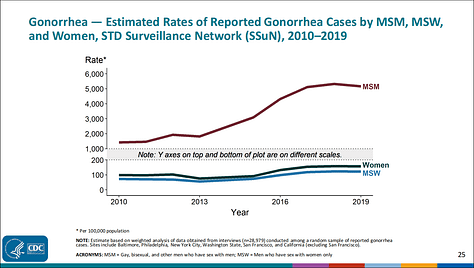




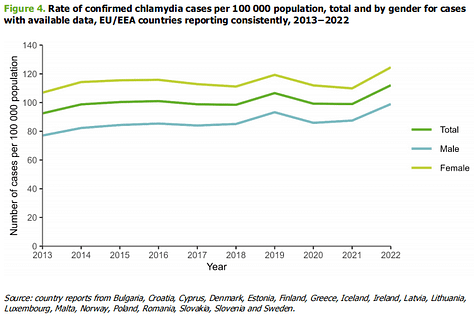
You may have noticed that there was one STD that women apparently contract in greater numbers: Chlamydia. If there aren’t more promiscuous women than heterosexual men, how is this possible? Anatomical differences may have something to do with it; for instance, cervical ectopy may make women especially susceptible to the disease (Lee et al., 2006). The main reason however may simply be that they’re screened at higher rates, as it’s believed that the adverse sequelae are more severe in women (e.g. pelvic inflammatory disease and infertility). The CDC (2007) determined that screening programs should be recommended to target young women:
A premise of the consultation was that STD programs should screen women less than 26 years of age for chlamydia infection as a primary focus (24;25) and that screening men for Ct should be considered as a secondary focus to prevent Ct infection and sequelae among women.
When we instead look at the positivity rate among those tested, we don’t find higher rates among women:

Regardless, just as with the other STDs, we don’t see a widening gap caused by dating app-facilitated Chadopolization. To the extent that these STDs are on the rise, it doesn’t necessarily reflect rising promiscuity, but for instance decreasing condom use—one thing which seems to buck the ‘risk aversion’ trend. It should also be said that if there was any doubt regarding self-reported sex partners, this data should largely bypass these concerns, unless you think the CDC is fudging the numbers to keep the Chadspiracy under wraps.
Finally, it has previously been revealed that the correlation between men’s attractiveness and sex partners is negligible at best. Is there any sign of an increase in this effect over time though? I ran a meta-regression model using studies/surveys with attractiveness and sex partners correlations with survey year as a moderating variable, and found no evidence for an increase in the effect size over the years:
I’ve also covered height, whose effect is virtually nonexistent, and likewise shows no sign of increasing post-dating apps.
What is true is that mating isn’t completely symmetrical. However, this asymmetry is found within each gender, and not so much across them. Where there is a between gender asymmetry is in desire for casual sex and variety. While it may be theoretically plausible that this sex difference would lead to the most desirable men fooling around with a bunch of women they wouldn’t be caught dead with in public, it could just as easily mean that promiscuity in the heterosexual community is not something which flourishes naturally in the absence of strict social norms opposing it, or even with the active promotion of sex positivity. It may be the case that monogamy isn’t quite what it used to be, with the institution of marriage waning and more short-lived pair bonds becoming more common. Sometimes serial monogamy is described as a form of ‘de facto polygyny’, but if this is so then the effect must be subtle enough to avoid clear detection in the sex partner data.
The narrative that uncommitted sexual encounters have replaced pair bonding as the normative sexual script has the potential to be harmful, as it fosters unrealistic expectations which when they are inevitably unmet could lead to disillusionment and resentment. This may be partially responsible for the rise of the Chadspiracy theory: ‘if women are hooking up left and right yet I'm missing out on this action, then they must be directing their lust toward that small pool of men who make them wet’. In reality, the data makes it clear that ‘hook-up culture’ can only be real in the weak sense that society is more tolerant of premarital sex, more intolerant of ‘slut shaming’, and so on—more of an attitudinal shift. Otherwise, when we’re talking about heterosexuals at least, we're at most talking about a fringe subculture. There may have been some sex-crazed nymphomaniac women being restrained by the shackles of sexual repression, but it doesn't seem like there were terribly many. The sexual revolution & feminism, the pill, antibiotics all did very little to undo eons of selection for sexual restrictedness in women.
When some people hear that ‘women are more selective’, they construe it as ‘they sleep around with a bunch of hot guys’. This is an especially prevalent notion within the incel community. They tend to believe that women are just as horny and open to uncommitted sex as men, but just for a smaller slice of the population:
The overrepresentation of autistic traits in this community may play a role, seeing as autism is associated with limited cognitive empathy. If anything, ‘black pillers’ aren't black pilled enough. Even ‘Chads’ don't just have sex handed to them on a silver platter. While it's conceivable that some of these men would figure that stringing women along and feigning commitment would be the most effective way to get sex out of them, it's probably not in most guys' nature to exploit people like this, or maybe even to exert the required effort (meaning it's a small percentage within a small percentage who'd be willing to), and also women tend to be good at sniffing out this kind of sexual deception (Buss, 2017). Many have speculated that the singleness gap in the Pew survey is a sign that this is becoming a widespread phenomenon, but as I’ve shown, this data is probably not accurate, and even if it was, the gap is primarily driven by a higher cohabitation and marriage rate among young women, leaving sneaky Machiavellian Chads with little room to spin their plates.
Aside from this, why do people believe the Chadopoly theory with such strong conviction despite such scant evidence?
A lot of it may simply come down to dating apps. The popularity of the ‘dating apps are facilitating Chadopolized hook-up culture’ narrative has grown to insane heights. It’s not too hard to see how at first glance the gender dynamics could create this impression. Women don't tend to swipe right on very many profiles, and as a result most men don't receive very many matches (though neither do most women, as they aren’t all matching with a bunch of ‘Chads’). For some reason that I still struggle to understand, otherwise intelligent people will frequently make wild and completely unjustified extrapolations from these observations. Why these are unjustified is detailed in this article:
The main takeaway though is that all of the available data on actual outcomes such as dates and sexual encounters shows no signs of across-sex inequality, similar to the population-level data on sexual behaviour.
For those who are frustrated with a lack of female contact, Chad can serve as a convenient scapegoat: if you don’t have something, it must be because a big bad bogeyman stole it from you. It’s arguably more comforting to imagine yourself as belonging to a burgeoning cohort of men victimized by a rigged system wherein ‘the winner takes all’ than it is to think you instead belong to a minority of men who are struggling for their own reasons. Then you have all those ‘chadfish’ videos and so on which tap into this frustration and insecurity and foster envy and resentment towards this character, and he moves into their heads rent-free.
When it comes down to it, the narrative never made much sense to begin with. Sixty years is a long time; at least 3 generations will have experienced the effects of ‘sexual liberation’. Sure, KISS and Van Halen may have had their fair share of groupies, but there doesn't seem to have been some widescale transition to a ‘de facto polygynous’ mating system. We also only started hearing reports of a so-called ‘incel epidemic’ in recent years. An appreciable gender gap in sexlessness only started emerging in the GSS data in 2018 (and again, reversed and closed in the subsequent surveys). Even if you argue that dating apps may have accelerated the imagined ‘Chadopolization’ process, there had to be something to accelerate to begin with—which it doesn’t seem like there’s evidence for—and there’s nothing which would have obviously preventing it from occurring. It’s almost like it never even began for Chad.
References
Larsen, M., & Kennair, L. E. O. (2024). Enough with the incels! A literary cry for help from female insings (involuntary single).Evolutionary Behavioral Sciences. Advance online publication. https://doi.org/10.1037/ebs0000349
Bearman, P. S., Moody, J., & Stovel, K. (2004c). Chains of Affection: the structure of adolescent romantic and sexual networks. American Journal of Sociology, 110(1), 44–91. https://doi.org/10.1086/386272
Harper, C. R., Dittus, P. J., Leichliter, J. S., & Aral, S. O. (2017). Changes in the Distribution of Sex Partners in the United States: 2002 to 2011-2013. Sexually transmitted diseases, 44(2), 96–100. https://doi.org/10.1097/OLQ.0000000000000554
Lindner, M. (2023). The Sense in Senseless Violence: Male Reproductive Strategy and the Modern Sexual Marketplace as Contributors to Violent Extremism. Adaptive Human Behavior and Physiology, 9(3), 217–251. https://doi.org/10.1007/s40750-023-00219-w
Räsänen, J. (2023). Sexual loneliness: A neglected public health problem? Bioethics, 37(2), 101–102. https://doi.org/10.1111/bioe.13134
Lee, V., Tobin, J. M., & Foley, E. (2006). Relationship of cervical ectopy to chlamydia infection in young women. The journal of family planning and reproductive health care, 32(2), 104–106. https://doi.org/10.1783/147118906776276440
Centers for Disease Control and Prevention. (2007). Male Chlamydia Screening Consultation, March 28-29, 2006, Meeting Report. Available at: https://www.cdc.gov/std/chlamydia/chlamydiascreening-males.pdf
Alexander. (2023). Male Attractiveness and Sexual Partner Count. Date Psychology. Available at: https://datepsychology.com/male-attractiveness-and-sexual-partner-count/
Buss, D. M. (2017). Sexual conflict in human mating. Current Directions in Psychological Science, 26(4), 307–313. https://doi.org/10.1177/0963721417695559
The latest survey result could just as easily be a random fluctuation in the other direction; the sample size for the GSS is low, especially after stratification. The NSFG shows evidence for a very mild trend which both started at a higher point and ended at a lower one than the GSS trend from 2008-18.




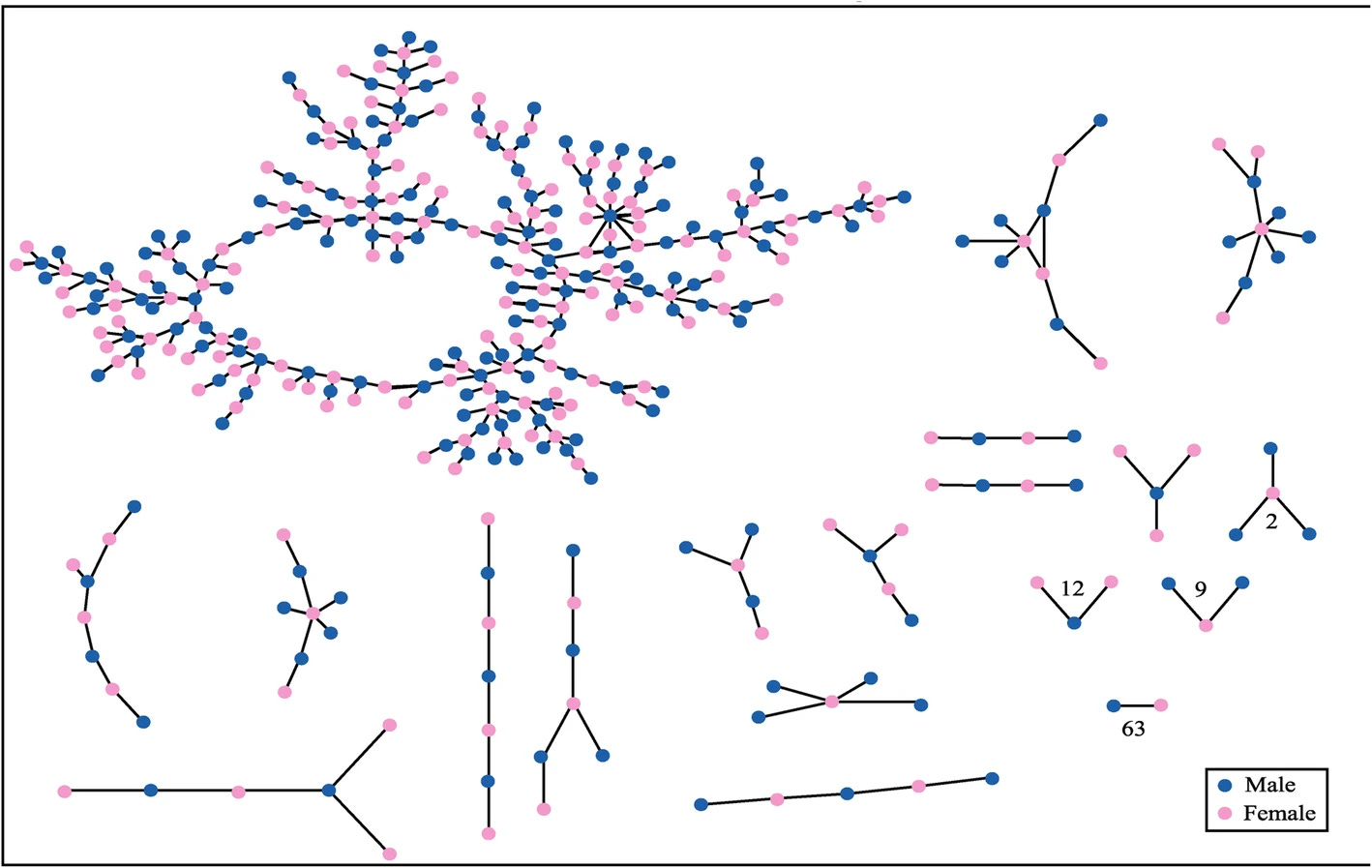
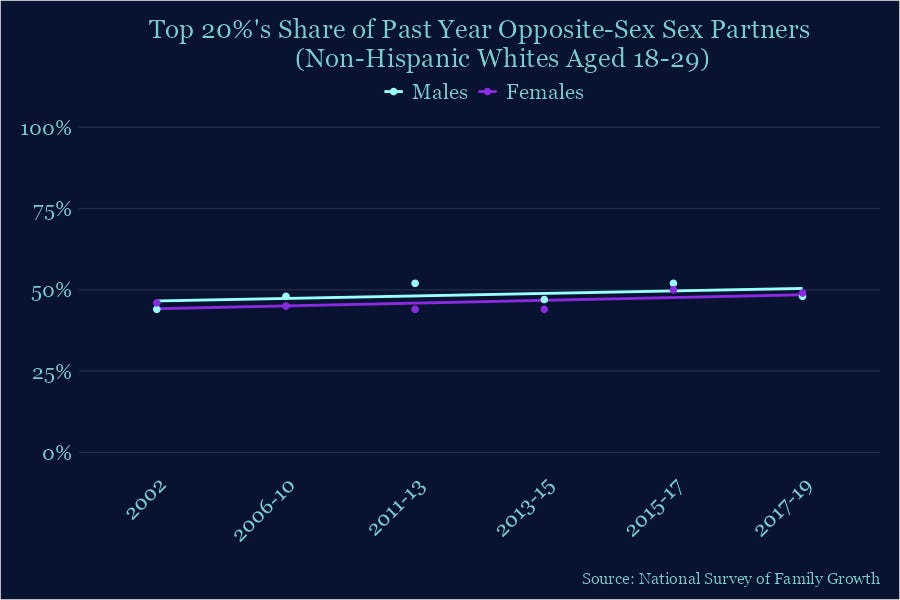
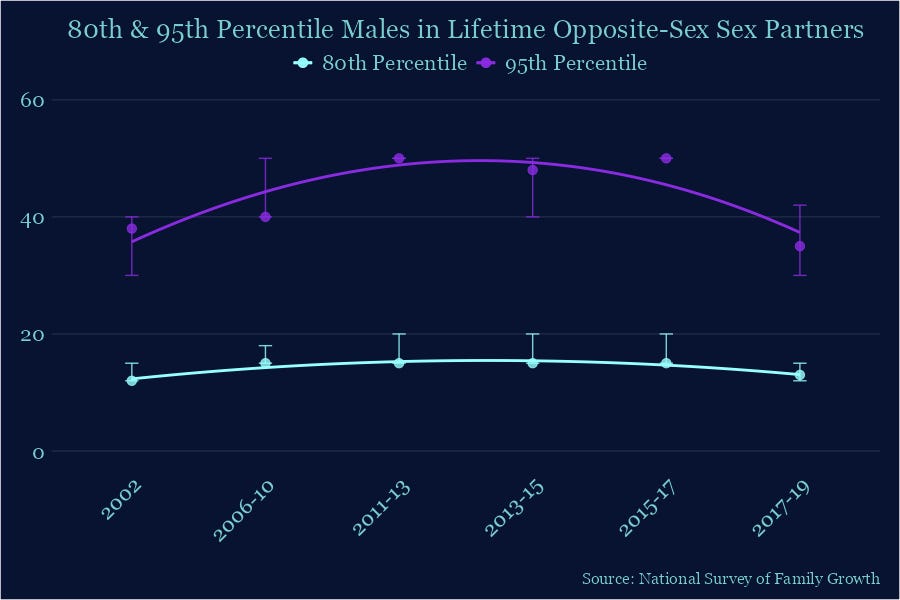











>The negligible correlations between attractiveness/height and sex partners have not risen in recent years.
This matches my intuition. I know not conv. attractive guys who have a lot of not conv. attractive sex partners. Most of "inceldom" is basically not accepting one's league. I distinctly remember being 16 and having two utterly different mental categories for attractive girls in the class, whom I categorized as "girls" and the other girls whom I categorized as "classmates".
Dating apps: so there are dating sites, which are used with a computer and revolve around writing and reading profiles, and dating apps, which are phone based and revolve around pics. These later are necessarily more looks-based, but there is also the part where a lot of guys really don't know how to take a good pic, the gym mirror selfie, the bathroom mirror selfie... generally the best idea is pics while doing interesting things.
Also, it is useful to conceptualize Tinder by comparing it to lottery, small chance of very high payoffs, with all the usual features of lottery.
stop trying to subvert our society jewy